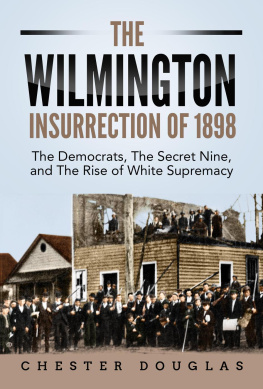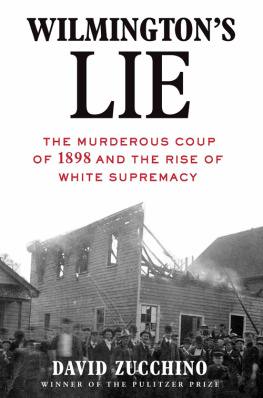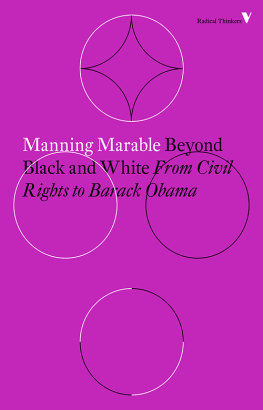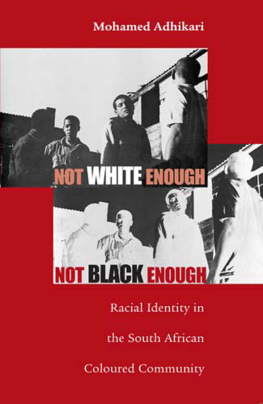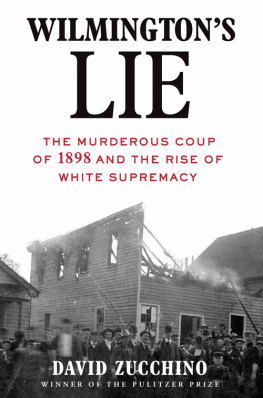Myth of the Welfare Queen
Thunder Run
WILMINGTONS
LIE
THE MURDEROUS COUP OF 1898 AND THE RISE OF WHITE SUPREMACY
DAVID ZUCCHINO

Copyright 2020 by David Zucchino
Cover design by Brbara Abbs
Cover photograph: Armed rioters pose with the destroyed
Record building, Wilmington, North Carolina, 1898.
Courtesy of New Hanover County Public Library,
North Carolina Room
All rights reserved. No part of this book may be reproduced in any form or by any electronic or mechanical means, including information storage and retrieval systems, without permission in writing from the publisher, except by a reviewer, who may quote brief passages in a review. Scanning, uploading, and electronic distribution of this book or the facilitation of such without the permission of the publisher is prohibited. Please purchase only authorized electronic editions, and do not participate in or encourage electronic piracy of copyrighted materials. Your support of the authors rights is appreciated. Any member of educational institutions wishing to photocopy part or all of the work for classroom use, or anthology, should send inquiries to Grove Atlantic, 154 West 14th Street, New York, NY 10011 or permissions@groveatlantic.com.
Photo credits are as follows: Photos 1.1 (fugitive slaves), 2.1 (Alfred Moore Waddell), 7.1 (rapid-fire gun crew), 7.2 (state militiamen), 12.2 (armed escort): Courtesy of the Cape Fear Museum of History and Science, Wilmington, NC. Photos 1.2 (Abraham Galloway), 5.2 (George Rountree), 9.2 (Donald MacRae), 10.2 (Fourth and Harnett): Courtesy of New Hanover County Public Library, North Carolina Room. Photos 2.2. (Alexander Manly), 3.1 (Furnifold Simmons), 3.2 (Democratic Hand Book), 4.1 (cartoon 1), 4.2 (cartoon 2), 4.3 (cartoon 3), 4.4 (cartoon 4), 5.1 (Remember the 6), 6.2 (John C. Dancy), 10.1 (committee response), 12.1 (Daniel Russell): Courtesy of the University of North Carolina at Chapel Hill, Wilson Special Collections Library. Photo 4.5 (Josephus Daniels): Courtesy of the Library of Congress, Prints and Photographs Division. Photo 6.1 (William Everett Henderson): Courtesy of Lisa Adams. Photos 8.1 (Charles Aycock), 8.2 (Red Shirts), 11.2 (burning Record ): Courtesy of the State Archives of North Carolina. Photo 9.1 (Roger Moore): Courtesy of the Internet Archive/NC Government and Heritage Library, originally published in Biographical History of North Carolina from Colonial Times to the Present, ed. Samuel ACourt Ashe (Greensboro, N.C.: C.L. Van Noppen, 1905). Photo 11.1 (Alex and Frank Manly): Courtesy of East Carolina University, Joyner Library.
FIRST EDITION
Published simultaneously in Canada
Printed in the United States of America
This title is set in 13-pt. Centaur by Alpha Design & Composition of Pittsfield, NH.
First Grove Atlantic hardcover edition: January 2020
Library of Congress Cataloging-in-Publication data available for this title.
ISBN 978-0-8021-2838-6
eISBN 978-0-8021-4648-9
Atlantic Monthly Press
an imprint of Grove Atlantic
154 West 14th Street
New York, NY 10011
Distributed by Publishers Group West
groveatlantic.com
20 21 22 23 10 9 8 7 6 5 4 3 2 1
To the dead and banished, known and unknown
CONTENTS

Charles Aycock His speeches incited whites to attack blacks. Conspired to deny blacks the vote. Elected governor in 1900.
Claude M. Bernard Republican US Attorney in Raleigh, failed to indict white supremacists for murders and coup
Robert H. Bunting White Republican, US Commissioner in Wilmington, married to black woman
Thomas Clawson White supremacist city editor of Wilmington Messenger, sold used press to Alex Manly
John C. Dancy Black customs collector at Wilmington port, counseled appeasement of white supremacists
Josephus Daniels Editor of News and Observer, militant voice of white supremacy campaign
Mike Dowling Brawling leader of a Red Shirt brigade in Wilmington
George Z. Gizzard French White Chief Deputy Sheriff in Wilmington, Republican targeted by coup leaders
Abraham Galloway Escaped slave, Union spy, state senator, early leader of black defiance in Wilmington
William E. Henderson Leading black lawyer and political figure in Wilmington
Captain Thomas C. James Commander of a Wilmington Light Infantry company
Edward Kinsley Massachusetts abolitionist, urged Abraham Galloway to raise black Union regiments in North Carolina
Reverend J. Allen Kirk Outspoken black minister in Wilmington, wrote A Statement of Facts
Captain Donald MacRae Commander of a Wilmington Light Infantry unit, brother of Hugh MacRae
Hugh MacRae Wealthy president of Wilmington Cotton Mills Co., leader of Secret Nine conspiracy
Alexander Manly Editor of black-readership Daily Record, confronted white power structure in Wilmington
Carrie Sadgwar Manly Wife of Alex Manly and vocalist for Fisk University Jubilee Singers
John Melton White Fusionist police chief of Wilmington, targeted by coup leaders
Thomas C. Miller Entrepreneur, wealthiest black man in Wilmington, loaned money to whites and blacks
Colonel Roger Moore Former Confederate officer, commander of Ku Klux Klan and Red Shirts in Wilmington
George Rountree White lawyer in Wilmington, leading organizer of coup
Daniel Russell Republican governor of North Carolina, member of Wilmington plantation gentry
Colonel William L. Saunders Former Confederate officer from Wilmington, commander of Ku Klux Klan in North Carolina
Armond Scott Young, ambitious black lawyer in Wilmington
Furnifold Simmons State Democratic Party chairman, political organizer of white supremacy campaign
James Sprunt Wealthy white owner of Sprunt Cotton Compress
J. Allan Taylor Member of Secret Nine conspiracy, brother of Walker Taylor
Lieutenant Colonel Walker Taylor Commander of Wilmington Light Infantry, member of Group Six conspiracy
Pitchfork Ben Tillman US senator from South Carolina, led white supremacist attacks on the states blacks
Colonel Alfred Moore Waddell Former Confederate officer in Wilmington, leading orator of white supremacy campaign
George Henry White US congressman from North Carolina, only black man in Congress in 1890s
Silas P. Wright White Republican mayor of Wilmington, targeted by coup leaders
The white mans happiness cannot be purchased by the black mans misery.
Frederick Douglass
White Mans Country
Wilmington, North Carolina, November 10, 1898
had tucked their trousers into their boot tops and tied cartridge belts around their waists. A few wore neckties. Each one carried a gun.
Throughout that summer and autumn, white men had been buying shotguns, six-shot pistols, and repeating rifles at hardware stores in the port city of Wilmington, North Carolina, set in the low Cape Fear country along the states jagged coast. It was 1898, a tumultuous midterm election year. White planters and business leaders had vowed to remove the citys multiracial government and black public officials by the ballot or the bulletor both. Few white men intended to navigate election week that November without a firearm within easy reach. There was concern among whites in Wilmington, where they were outnumbered by blacks, that stores would run dry on guns and that suppliers in the rest of the state and in nearby South Carolina would be unable to meet the demand.
Next page


